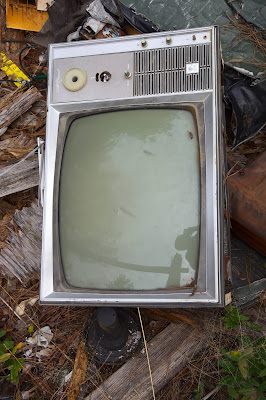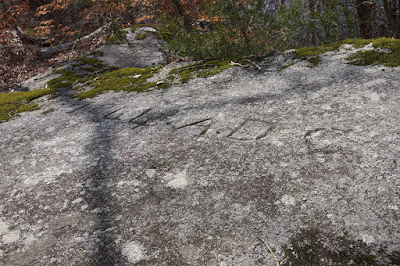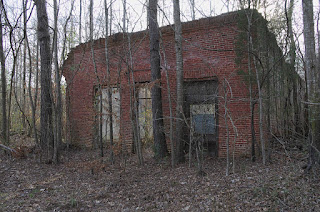Photo trek to Laurens and Newberry Counties
Having some free time this week, I decided to fill some of the time with a photo trek to visit some historic sites in Laurens and Newberry Counties.
My first stop is a rusty old bridge over the Enoree river at the Union-Laurens County line.
View Larger Map
A few hundred feet downstream is an even older rustier bridge long ago replaced by the current one.
Nearby Sumter National Forest was my next stop. While searching through photos of the area on Panoramio, I found an interesting picture of a rock carved with "1844 A.D.C". So far, I have been unable to find an online history of the carving, so I don't yet who carved it or why. The carved rock is down a path accessible from the end of a forest service road.
Open large map
The forest service sign marking the road was down, but my trip GPS said it was the correct road so I turned in.
At the end of the road is a turnaround where I parked my car. The trailhead is at the gate.
Continue on past the dark red Duncan Creek Waterflowl Management area sign.
Not far past the sign, a faint path forks off to the right:
Follow the path as best you can until you get to the rocks at the edge of the swamp. I had to search around a little before I found it. While the carving is easily visible in person, I still had to play with angles so the carving was easily visible in the photo.
Duncan Creek Presbyterian Church was my next stop.
View Larger Map
Duncan Creek Presbyterian Church first organized in 1752, making it (possibly) the oldest organized church in Laurens County. The present stone sanctuary was built in 1843 with a more modern clay brick structure behind.
The cemetery, located to the left, is of historical interest. Its earliest grave dates from 1776.
Renno, a ghost town, was my next stop.
View Larger Map
Renno sprouted in the 1890s thanks to the coming of the railroad. According to an architectural survey of Laurens County, at one time Renno had three general stores, a blacksmith shop, cotton gin, a train depot, and a few other businesses. In 1912, Renno school was built on the north side of town.
Down the road a few miles, my next stop was the former resort of Stomp Springs. Stomp Springs was already locally famous for its mineral spring water when Thomas E. Hair of Columbia bought the property in 1946 with big plans for development.
After some success, the operation went bankrupt. Not much is left of the buildings except ruins and rubble. The spring still flows from the same pipe that was installed back in the 1920s.
Unfortunately, the whole place is a mess. Bottles, trash, and debris litter the whole area.
While taking these pictures, I happened to see a rural mail carrier travel around the loop. I couldn't help but wonder how long it's been since that mail carrier has delivered one piece of mail around here.
Riser Brick House was the next place on the agenda. Riser Brick House is in the Laurens County near the Newberry County line. Riser Brick House was built in 1830 and served as a stagecoach stop between Whitmire and present day Joanna. Jefferson Davis may have passed by the house while evading capture at the end of the Civil War.
View Larger Map
While I did have plans to visit more sites in the area, the clouds were moving in and the sun was starting to get low in the sky, so I chose to move along to Chappells.
My online research found no online photos of Chappells until I found a photo of Chappells Depot supplied by Mrs. Caroline Holloway (deceased) for the October 3, 1988 edition of The Newberry Observer. This version of the photo was printed, possibly microfilmed, and digitized making it a few generations removed from the original, yet still good enough to give an idea of what the depot looked like.
The Leaman Brothers building in Cross Hill was my last stop before heading home.
J. E. Leaman opened the store on Main Street in 1912 and would operate the store until after World War II when his son took over. A short distance away is a Confederate monument and a building with some "ghost signs".
I was tempted to explore more of Cross Hill, but it was getting close to sundown, however, so I reluctantly called it a day and went home.
More photos from the trek can be found at Google or Flickr.
References
Open large map
The forest service sign marking the road was down, but my trip GPS said it was the correct road so I turned in.
At the end of the road is a turnaround where I parked my car. The trailhead is at the gate.
Continue on past the dark red Duncan Creek Waterflowl Management area sign.
Not far past the sign, a faint path forks off to the right:
Follow the path as best you can until you get to the rocks at the edge of the swamp. I had to search around a little before I found it. While the carving is easily visible in person, I still had to play with angles so the carving was easily visible in the photo.
Duncan Creek Presbyterian Church was my next stop.
View Larger Map
Duncan Creek Presbyterian Church first organized in 1752, making it (possibly) the oldest organized church in Laurens County. The present stone sanctuary was built in 1843 with a more modern clay brick structure behind.
The cemetery, located to the left, is of historical interest. Its earliest grave dates from 1776.
 |
| Samual Long, dies Nov. 1776 aged 19 |
The graveyard hosts a few graves of American Revolution War participants, among them is Mary Ramage Dillard.
 |
| Mary Ramage Dillard |
The graveyard also hosts a few participants in the American Civil War, including Cornelius Tribble, killed in action.
Renno, a ghost town, was my next stop.
View Larger Map
Renno sprouted in the 1890s thanks to the coming of the railroad. According to an architectural survey of Laurens County, at one time Renno had three general stores, a blacksmith shop, cotton gin, a train depot, and a few other businesses. In 1912, Renno school was built on the north side of town.
 |
| 1924 insurance photograph |
Today, the school is in ruins and Renno is a ghost town. Renno failed in the 1930s because area farmers lost their land and improved roads made railroads (and railroad towns like Renno) less important.
Down the road a few miles, my next stop was the former resort of Stomp Springs. Stomp Springs was already locally famous for its mineral spring water when Thomas E. Hair of Columbia bought the property in 1946 with big plans for development.
 |
| Electric baths? No thanks! |
After some success, the operation went bankrupt. Not much is left of the buildings except ruins and rubble. The spring still flows from the same pipe that was installed back in the 1920s.
 |
| The spring still flows |
 |
| Business building |
 |
| Stairs to nowhere |
Unfortunately, the whole place is a mess. Bottles, trash, and debris litter the whole area.
 |
| Got TV? |
While taking these pictures, I happened to see a rural mail carrier travel around the loop. I couldn't help but wonder how long it's been since that mail carrier has delivered one piece of mail around here.
Riser Brick House was the next place on the agenda. Riser Brick House is in the Laurens County near the Newberry County line. Riser Brick House was built in 1830 and served as a stagecoach stop between Whitmire and present day Joanna. Jefferson Davis may have passed by the house while evading capture at the end of the Civil War.
View Larger Map
While I did have plans to visit more sites in the area, the clouds were moving in and the sun was starting to get low in the sky, so I chose to move along to Chappells.
 |
| Chappells Post Office |
Thomas Chappell built a home and a ferry business at what is now Chappells in the early 19th century. The construction of a railroad line in 1852 aided growth. But an area wide flood in 1928 washed away the bridge and covered parts of town in nearly 10 feet of water. A new bridge was finished in 1931 about 1/3 mile downstream on present SC 38, diverting traffic away from Main Street. Better roads, decreased dependence on railroads, and a 1940 fire meant that Chappells was no longer a center of commerce.
Main street is now a cul-de-sac, the rails have been removed, and the depot is long gone. The old post office and a convenience store are the only active businesses I found. And unfortunately for Chappells, the Chappells Post Office is one of many on the list of proposed post office closures.
Main street is now a cul-de-sac, the rails have been removed, and the depot is long gone. The old post office and a convenience store are the only active businesses I found. And unfortunately for Chappells, the Chappells Post Office is one of many on the list of proposed post office closures.
 |
| Main street now ends in a cul-de-sac |
My online research found no online photos of Chappells until I found a photo of Chappells Depot supplied by Mrs. Caroline Holloway (deceased) for the October 3, 1988 edition of The Newberry Observer. This version of the photo was printed, possibly microfilmed, and digitized making it a few generations removed from the original, yet still good enough to give an idea of what the depot looked like.
The Leaman Brothers building in Cross Hill was my last stop before heading home.
J. E. Leaman opened the store on Main Street in 1912 and would operate the store until after World War II when his son took over. A short distance away is a Confederate monument and a building with some "ghost signs".
I was tempted to explore more of Cross Hill, but it was getting close to sundown, however, so I reluctantly called it a day and went home.
More photos from the trek can be found at Google or Flickr.
References
- Historical and Architectural Survey of Eastern Laurens County by the Palmetto Conservation Foundation at National Register Properties in South Carolina. Includes a history of Duncan Creek Presbyterian Church, Renno, Riser Brickhouse, and Cross Hill.
- Historical and Architectural Survey of Newberry County by the Palmetto Conservation Foundation at National Register Properties in South Carolina. Includes a history of Chappells.
More about Duncan Creek Presbyterian Church
- Listing at the National Register Properties in South Carolina website.
- Genealogical information at Adair and Holland Families First South Carolina Cavalry and more...
- Find A Grave's page about the church cemetery.
More about Renno
- Laurens County Veterans Meet from the September 10, 1913 Herald-Journal. The second part of the story is about the opening of the new Renno school.
More about Stomp Springs
- Stomp Springs Is Sold By Clary in the July 25, 1944 Herald-Journal. Stomp Springs is being sold to Thomas E. Hair of Columbia.
- Clinton Resort Now Building To Open Next Year in the August 12, 1951 The News and Courier.
- Stomp Springs Home For Aged To Open Soon in the April 25, 1958 Newberry Observer.
- Community For Retired Becomes Reality Soon in the July 27, 1957 Herald-Journal. With pictures of the construction work.
- Stomp Springs: Water's Still Marketed in the February 15, 1972 Newberry Observer. Brief history of the springs and many pictures.
- Cruising... in the July 5, 1979 Newberry Observer.
More about Chappells
- Unpublished fire insurance map of Chappells by Sanborn, 1926 at the South Carolina Digital Archives
- At Chappells in the September 9, 1909 The Observer.
- Award Contract For New Bridge in the July 21, 1931 The Newberry Observer.
- Chappells in the April 28, 1939 The Newberry Observer.
- Fire at Chappells (4th paragraph) in the May 21st, 1940 The Newbery Observer.
- Chappells Survives Early Floods, Cyclones in the 1976-08-24 The Newberry Observer.
- A Town Rich In Its Heritage, Chappells Is Ideal for Retirees (continued) in the 1988-10-03 The Newberry Observer.
- The Town of Chappells in the 1998-03-29 The Newberry Observer.
- Greenwood to Alston at Abandoned Rails. Explains what happened to the railroad that passed by Chappells.




















Thanks for this. My family (Jacks) settled this area around 1750.
ReplyDelete